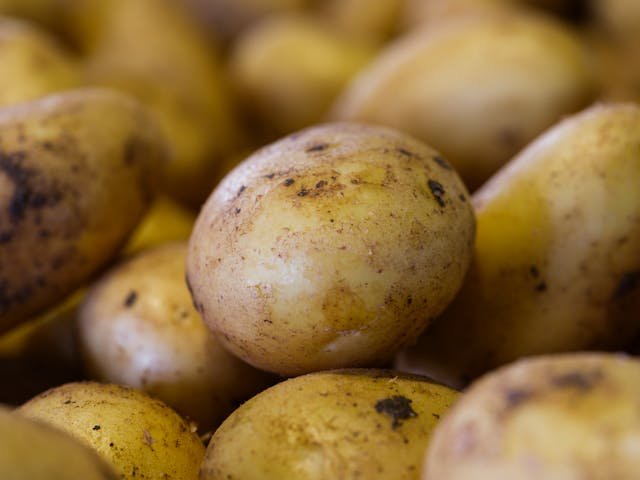Overview
Russet potatoes are often underestimated. Affordable, versatile and widely loved, they are more than just a side-dish — they supply important nutrients, can support athletic performance, and fit into both budget-conscious and health-focused meal plans. This revised article reframes russet potato nutrition with fresh examples, new recipe ideas, region-friendly tips, and updated guidance for people managing blood sugar, weight, or athletic recovery. Authoritative sources are referenced so readers can check figures if they wish.
What makes a russet potato nutritious?
A typical medium russet with the skin on is primarily a starchy carbohydrate food that also provides meaningful amounts of potassium, vitamin C, vitamin B6 and dietary fibre. For many people it delivers energy, satiety and micronutrients at a low cost per serving. Exact nutrition values change with size, cultivar and soil conditions, but a medium russet commonly contains roughly 150–200 kilocalories, about 35–40 g of carbohydrate, 3–5 g protein, under 1 g fat and 3–4 g fibre when eaten with the skin.
Why this matters: these nutrients support daily energy needs, nerve and muscle function (potassium), antioxidant protection (vitamin C) and metabolism (B6). For precise, weight-based nutrient numbers you can consult national food tables such as USDA FoodData Central. (See further reading at the end.)
Key nutrients explained
Potassium — the electrolyte powerhouse
Potassium helps balance sodium, supports normal blood-pressure regulation and is essential for muscle contractions and nerve impulses. A medium russet can contribute a substantial portion of your daily potassium requirement, making potatoes a simple, inexpensive source of this mineral.
Vitamin C — an unexpected source among starches
Unlike many grains and starchy roots, potatoes supply vitamin C. This water-soluble antioxidant supports immune health and tissue repair. Because vitamin C is heat-sensitive and water-soluble, cooking choices influence how much remains in the finished dish.
Vitamin B6 and energy metabolism
Russets provide vitamin B6, which assists in converting food into usable energy and supports nervous system health. B vitamins are readily available across many staple foods, but including potatoes helps diversify sources.
Dietary fibre — mostly in the skin
Most of a potato’s dietary fibre is concentrated in or just beneath the skin. Eating russets unpeeled increases fibre intake, which slows carbohydrate absorption, improves satiety and supports gut health.
How russets compare to other tubers and roots
Russets are starchy — they break down well when baked or mashed. Waxy varieties (red or new potatoes) stay firmer after boiling and sometimes have slightly different starch profiles. Sweet potatoes are richer in beta-carotene (vitamin A precursor) and have a different micronutrient emphasis. Rotating potato types and other root vegetables adds variety in texture and micronutrients across your weekly meals.
Glycaemic response: practical perspective
Russet potatoes can have a relatively high glycaemic response, particularly when baked and eaten hot. Still, the glycaemic effect is malleable: portion size, meal composition (protein, fat, fibre), and preparation method all shape how quickly glucose enters the bloodstream. For everyone — especially people with diabetes or prediabetes — pairing potatoes with protein and vegetables and watching portion sizes will help stabilise post-meal blood glucose.
Resistant starch: improve potato nutrition with cooling
Cooked and then cooled potatoes form resistant starch, a carbohydrate fraction that resists digestion in the small intestine and feeds beneficial gut microbes in the colon. Resistant starch behaves more like fibre than a simple sugar; it can reduce post-prandial glucose spikes and improve gut health. Make potato salads, chill roasted cubes, or cook, chill and gently reheat potatoes to increase resistant starch content.
Cooking methods and nutrition — what changes?
Baking and roasting
Dry heat methods preserve more micronutrients than prolonged boiling. Roasted or baked russets keep their texture and are ideal when you want a high-volume, filling component without extra oil.
Boiling
Boiling can leach water-soluble vitamins (like vitamin C and some B vitamins) into the water. To retain more nutrients keep the skin on and avoid excessive boiling time, or reuse the cooking liquid where safe and appropriate.
Deep-frying
Deep-fried potatoes (chips, fries) become high in energy density and fat. Frequent consumption increases daily calorie intake substantially and may expose foods to higher levels of heat-induced compounds (e.g., acrylamide). Reserve deep-fried treats for occasional enjoyment.
Air-frying
Air-frying reduces added oil while producing a crisp texture similar to deep-frying. It’s a good compromise for flavour without the calorie penalty.
Cooling and reheating
Cooling cooked potatoes in the refrigerator overnight increases resistant starch. Gentle reheating or eating chilled yields a lower effective glycaemic load versus freshly baked hot potatoes.
Serving sizes: what’s realistic?
A reasonable portion for many adults is one medium russet; half a potato may be suitable when paired with other carbohydrate sources, or for those controlling caloric intake. Athletes and highly active people often need larger portions to replenish glycogen. Tailor portions to energy needs and health goals rather than using a one-size-fits-all rule.
Russet potato nutrition for specific goals
For weight control
Russets can assist weight management because they are filling per calorie, particularly when eaten with the skin and accompanied by lean protein and vegetables. Avoid heavy toppings (large amounts of butter, cream, or cheese) and frequent deep-fried versions.
For athletic recovery
Potatoes are rapid sources of carbohydrate for glycogen restoration after intense training. When combined with a protein source (e.g., chicken, yogurt, whey), they support recovery and muscle repair. Potassium also helps restore electrolytes lost in sweat.
For heart health
Potassium-rich foods are associated with better blood-pressure control when dietary sodium is moderated. Choosing baked or roasted potatoes without excessive salt or saturated fat supports cardiovascular goals.
For blood-sugar management
People with diabetes should focus on portion control, cooking method and meal composition. Cooling potatoes to increase resistant starch, combining with protein/fat/fibre, and avoiding large single-serve portions will blunt glycaemic responses.
Who should limit intake or exercise caution?
Individuals with advanced kidney disease or on medications that alter potassium levels should discuss potato consumption with their clinician because of the potassium content. Those on very low-carbohydrate therapeutic diets will likely avoid russets due to starch content. People with insulin resistance should monitor blood glucose responses and adjust portion sizes to personal tolerance.
Practical tips to get the most nutrition and flavour
- Leave the skin on — it’s the richest place for fibre and many micronutrients; scrub it well before cooking.
- Prefer dry-heat or air-frying when you want texture with low added fat.
- Pair with protein and vegetables to create balanced plates and to slow glucose absorption.
- Cook, chill and serve in salads to increase resistant starch and reduce glycaemic impact.
- Flavour without excess calories using herbs, spices and citrus instead of large amounts of butter or salt.
Fresh recipe ideas and variations
- Mediterranean stuffed russet: Bake a russet, split and fill with sautéed spinach, chickpeas, lemon zest and a spoonful of low-fat Greek yoghurt.
- Chilled potato and lentil salad: Cook and cool potato cubes, toss with green lentils, red onion, parsley and a mustard-vinegar dressing. Great post-workout or as picnic fare.
- Quick athlete’s plate: Oven-roasted russet wedges, grilled chicken breast, steamed broccoli and a citrus dressing — carbs + protein + greens.
- Light mashed potato: Mash with a splash of olive oil and oat milk, fold in chopped steamed kale for extra fibre and iron.
These variations emphasise different audiences: families, athletes, vegetarians and those seeking lighter comfort food.
Cost, storage and sustainability
Russets store well in a cool, dark, dry place and are often less expensive per calorie than animal proteins. On a per-calorie basis, many plant foods — including potatoes — can have a favourable environmental footprint. Choosing seasonal produce and minimising waste (use peels in compost) improves sustainability further.
Common myths — debunked briefly
“Potatoes are empty calories.”
Potatoes provide vitamin C, vitamin B6, potassium and fibre (with skin). Preparation and portioning determine whether they’re nutrient-dense or calorie-laden.
“Potatoes always spike blood sugar.”
Not invariably. Glycaemic impact depends on variety, cooking method, portion size and the meal context. Cooling to increase resistant starch and pairing with protein and fibre moderates blood-glucose response.
Quick nutrient snapshot (approximate — medium russet, skin on)
- Energy: ~150–200 kilocalories
- Carbohydrate: ~35–40 g
- Protein: ~3–5 g
- Fat: <1 g
- Fibre: ~3–4 g (higher with skin)
- Potassium: substantial amount — a meaningful contribution to daily needs
- Vitamin C & B6: present in useful quantities
For laboratory-accurate values consult the USDA FoodData Central database or comparable national food composition tables.
Practical publishing note for your websites
If you plan to publish different versions across two sites, consider adding a unique introduction, location-specific recipes, or a different author bio to make each page distinct for search engines. Alternatively, use technical methods (rel=canonical or a noindex tag) if you prefer one authoritative copy.
Further reading & authoritative sources
- USDA FoodData Central — detailed nutrient profiles and food composition tables.
- Harvard T.H. Chan School of Public Health — evidence-based articles on potatoes and healthy eating patterns.
- NHS (UK) and Mayo Clinic — practical clinical guidance on potassium, blood sugar, and general dietary concerns.
(Readers may search those site names for the most current pages and figures.)
Frequently Asked Questions (FAQs)
Q: Are russet potatoes compatible with a weight-loss plan?
A: Yes. When portioned sensibly, served with protein and vegetables, and cooked without excess fat, russets can be filling and supportive of weight control.
Q: What’s the best way to reduce the glycaemic impact of a potato meal?
A: Reduce portion size, eat the potato with protein and fibre-rich foods, and consider cooking then cooling the potato to increase resistant starch.
Q: Is it healthier to eat potatoes with or without the skin?
A: With the skin — it contains most of the fibre and additional micronutrients.
Q: How should athletes use russets?
A: Use russets as a carbohydrate source for pre- or post-exercise meals paired with protein to maximise glycogen replenishment and muscle repair.
Q: Are russets high in potassium?
A: Yes — they are a useful dietary source of potassium. People with kidney disease or those on potassium-altering medications should consult a clinician.
Disclaimer
This article is educational and not a substitute for professional medical advice. Nutrient contents vary by potato size, variety and preparation method. If you have medical conditions such as diabetes, chronic kidney disease, or require specialised nutrition advice, consult a registered dietitian or healthcare professional. For precise nutrient data, refer to national food composition databases such as USDA FoodData Central.
If you’d like, I can now:




